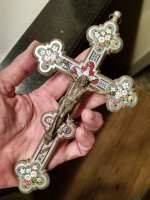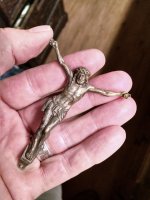DownNDirty
Bronze Member
Yesterday I found this figurine of Christ on the cross (without the cross). It's 4.3 inches tall and is made of either brass or bronze. I was detecting an area where there were multiple buildings on a main road, possibly at a primary road crossing; the figurine was in the iron patch of one of the buildings. All of the relics I have found there date to the 1700s or 1800s including flat buttons with and without back marks so I think it's safe to say that it was made sometime in those two centuries.



It obviously attached to a cross, based on the rectangular hole in the back and small hole in the one remaining hand. The bottom part was bent forward, probably by a plow. The platform that the feet are attached to would have originally been facing the other way and would have been parallel to the cross. I'm not sure why the cross wasn't incorporated with the figurine, i.e. why it was detachable. Maybe the Christ figure was only displayed during Lent?
I know basically what it is, but I need help trying to figure out:
1. Is there any way to get a closer date range than 200 years? At least the century that it was made in
2. Is it more likely that it was privately owned, or would something like this have been in a church?
As always I appreciate any input given. Thanks



It obviously attached to a cross, based on the rectangular hole in the back and small hole in the one remaining hand. The bottom part was bent forward, probably by a plow. The platform that the feet are attached to would have originally been facing the other way and would have been parallel to the cross. I'm not sure why the cross wasn't incorporated with the figurine, i.e. why it was detachable. Maybe the Christ figure was only displayed during Lent?
I know basically what it is, but I need help trying to figure out:
1. Is there any way to get a closer date range than 200 years? At least the century that it was made in
2. Is it more likely that it was privately owned, or would something like this have been in a church?
As always I appreciate any input given. Thanks
Last edited:





